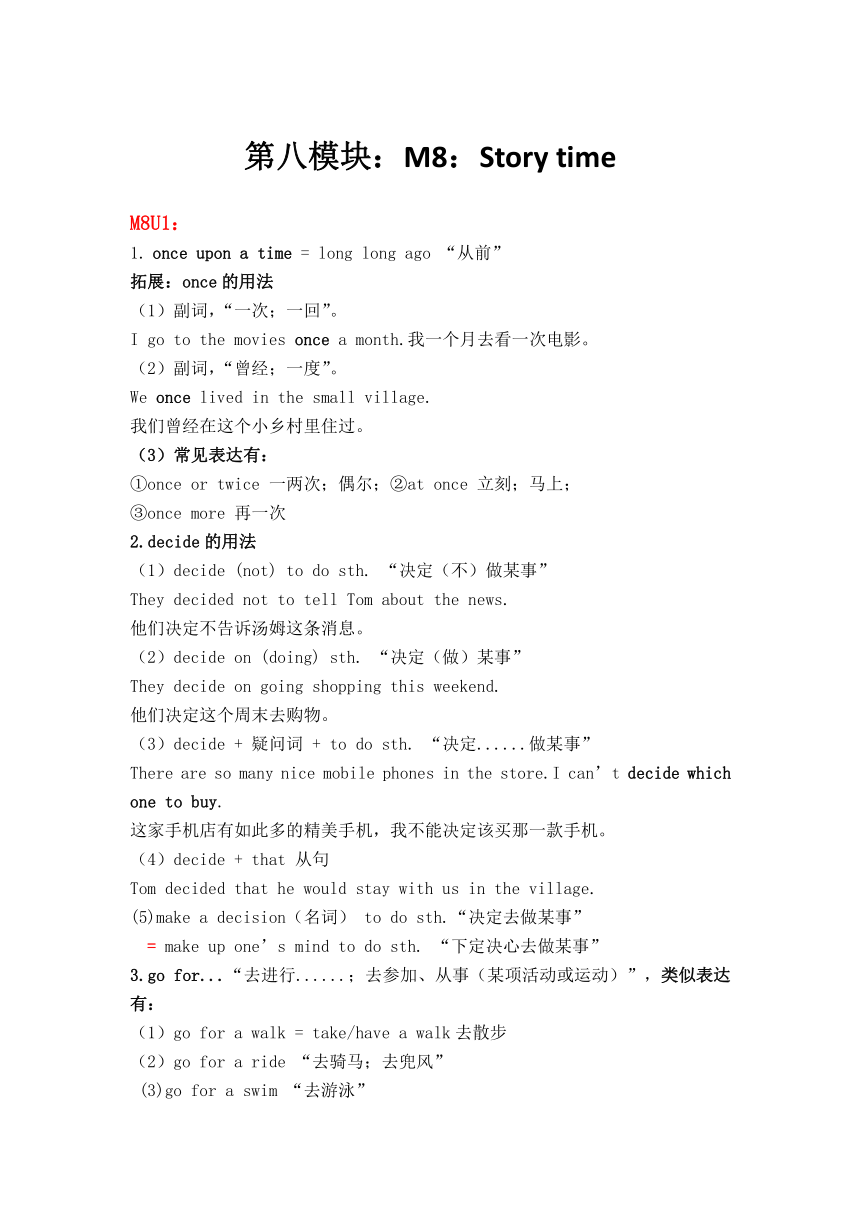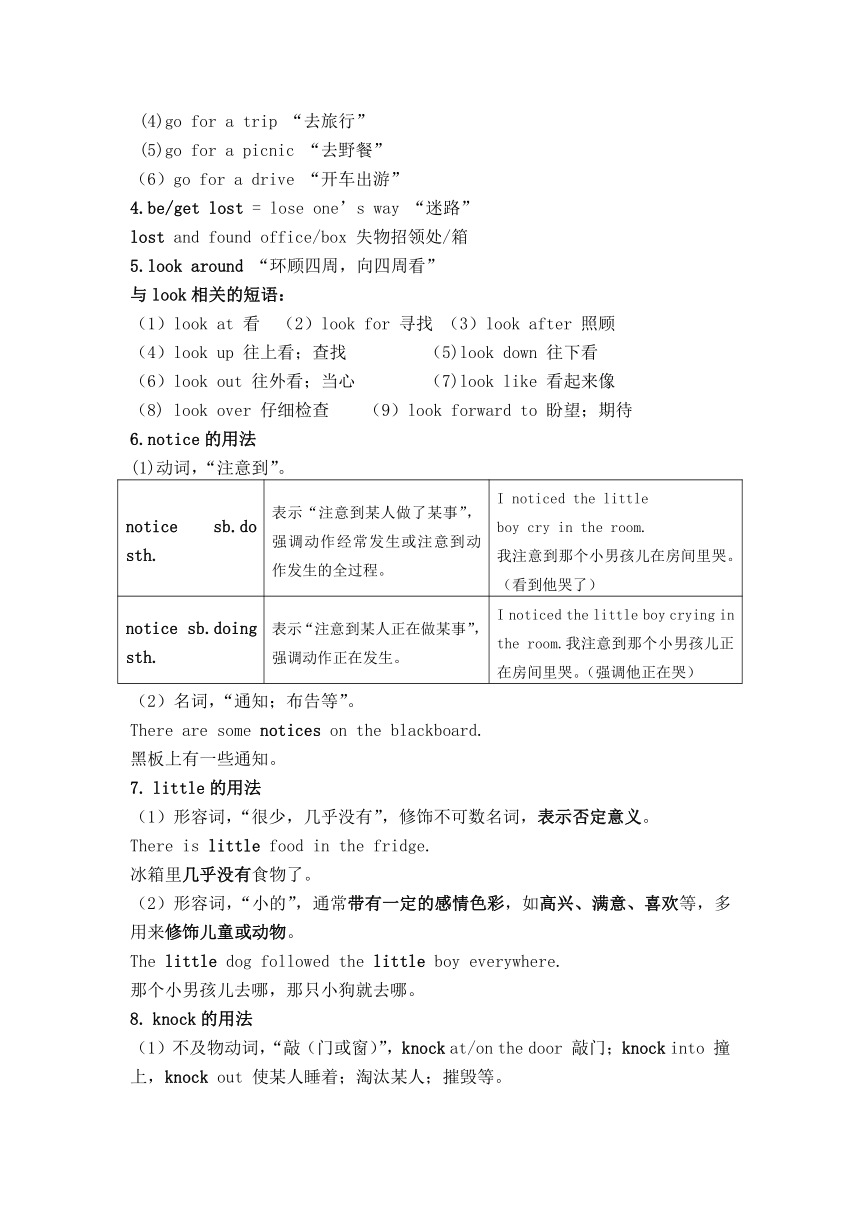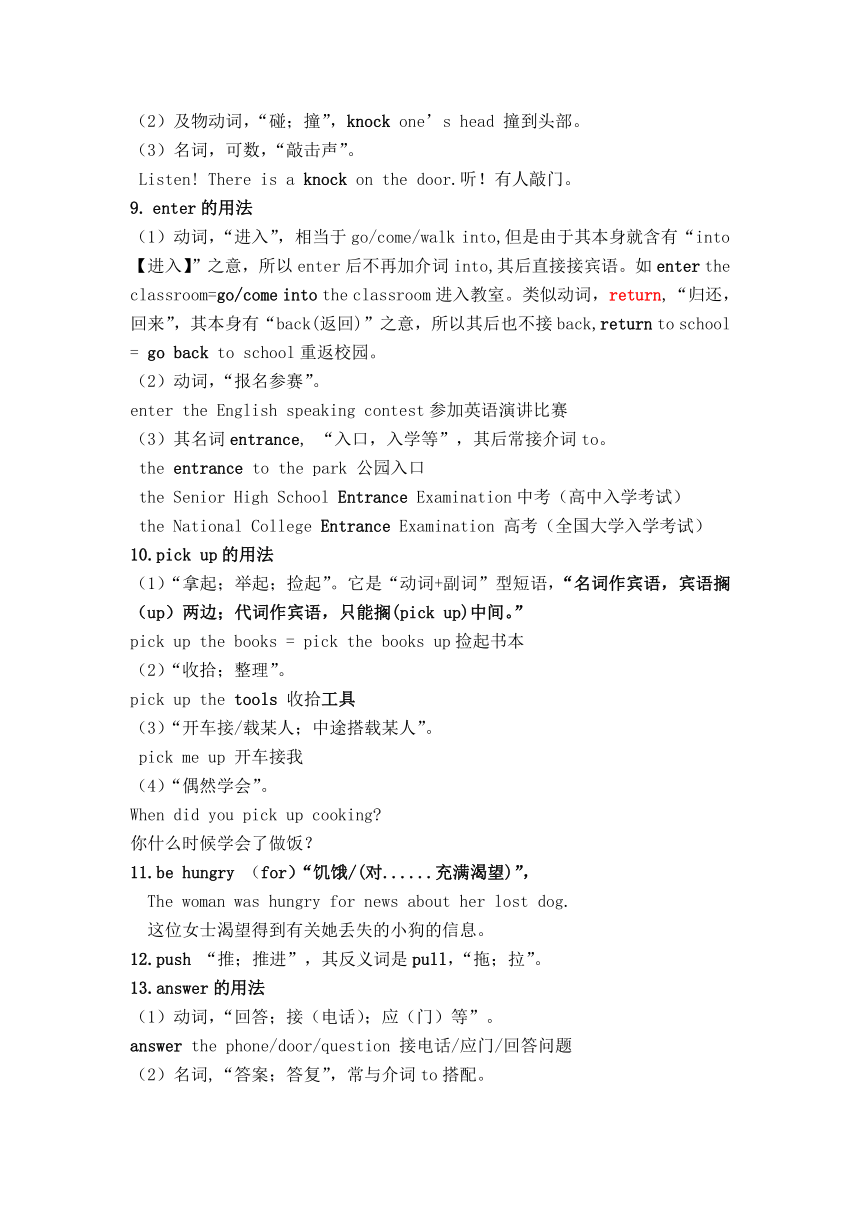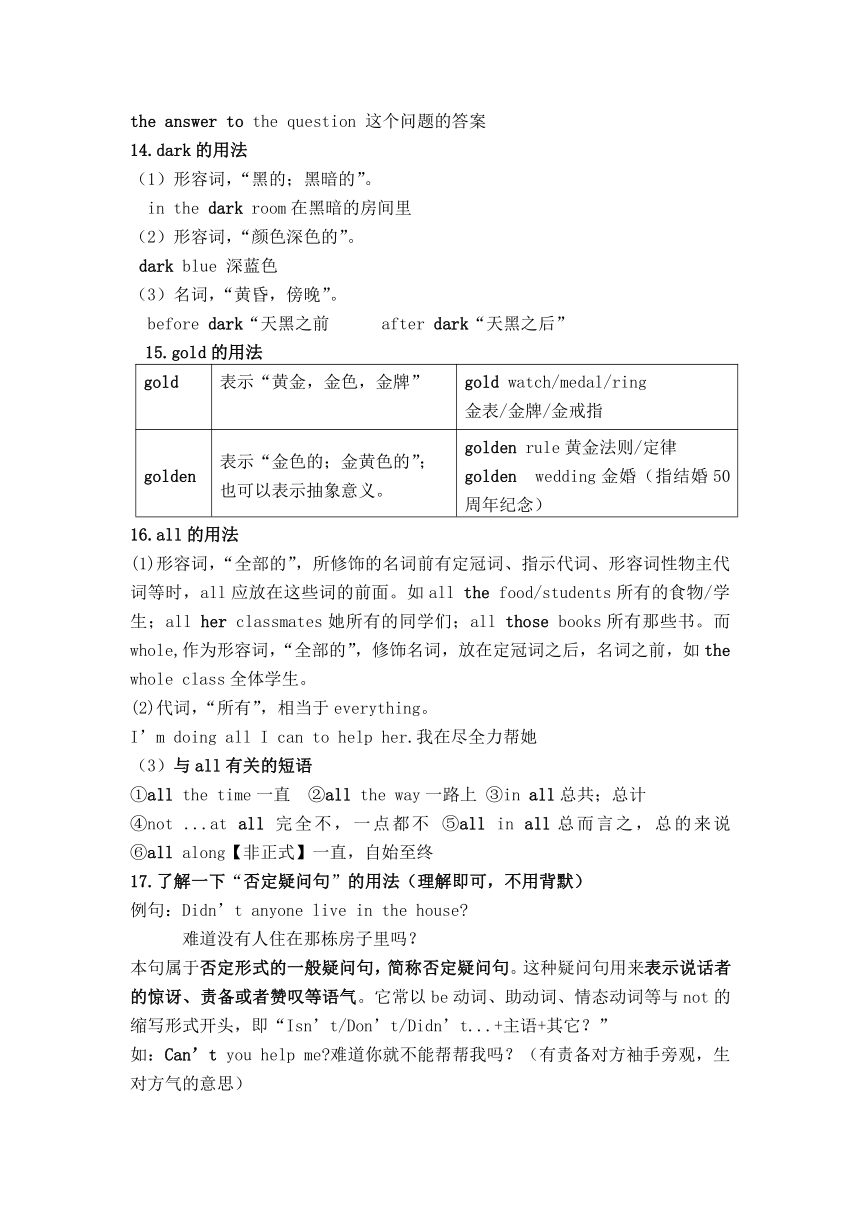外研版英语七下第八模块Module 8 Story time重要知识点
文档属性
| 名称 | 外研版英语七下第八模块Module 8 Story time重要知识点 |  | |
| 格式 | zip | ||
| 文件大小 | 61.5KB | ||
| 资源类型 | 教案 | ||
| 版本资源 | 外研版 | ||
| 科目 | 英语 | ||
| 更新时间 | 2020-05-23 19:55:03 | ||
图片预览




文档简介
第八模块:M8:Story time
M8U1:
once upon a time = long long ago “从前”
拓展:once的用法
副词,“一次;一回”。
I go to the movies once a month.我一个月去看一次电影。
副词,“曾经;一度”。
We once lived in the small village.
我们曾经在这个小乡村里住过。
常见表达有:
①once or twice 一两次;偶尔;②at once 立刻;马上;
③once more 再一次
2.decide的用法
decide (not) to do sth. “决定(不)做某事”
They decided not to tell Tom about the news.
他们决定不告诉汤姆这条消息。
decide on (doing) sth. “决定(做)某事”
They decide on going shopping this weekend.
他们决定这个周末去购物。
decide + 疑问词 + to do sth. “决定......做某事”
There are so many nice mobile phones in the store.I can’t decide which one to buy.
这家手机店有如此多的精美手机,我不能决定该买那一款手机。
decide + that 从句
Tom decided that he would stay with us in the village.
(5)make a decision(名词) to do sth.“决定去做某事”
= make up one’s mind to do sth. “下定决心去做某事”
3.go for...“去进行......;去参加、从事(某项活动或运动)”,类似表达有:
(1)go for a walk = take/have a walk去散步
(2)go for a ride “去骑马;去兜风”
(3)go for a swim “去游泳”
(4)go for a trip “去旅行”
(5)go for a picnic “去野餐”
(6)go for a drive “开车出游”
4.be/get lost = lose one’s way “迷路”
lost and found office/box 失物招领处/箱
5.look around “环顾四周,向四周看”
与look相关的短语:
(1)look at 看 (2)look for 寻找 (3)look after 照顾
(4)look up 往上看;查找 (5)look down 往下看
(6)look out 往外看;当心 (7)look like 看起来像
(8) look over 仔细检查 (9)look forward to 盼望;期待
6.notice的用法
(1)动词,“注意到”。
notice sb.do sth. 表示“注意到某人做了某事”,强调动作经常发生或注意到动作发生的全过程。 I noticed the littleboy cry in the room.我注意到那个小男孩儿在房间里哭。(看到他哭了)
notice sb.doing sth. 表示“注意到某人正在做某事”,强调动作正在发生。 I noticed the little boy crying in the room.我注意到那个小男孩儿正在房间里哭。(强调他正在哭)
(2)名词,“通知;布告等”。
There are some notices on the blackboard.
黑板上有一些通知。
little的用法
形容词,“很少,几乎没有”,修饰不可数名词,表示否定意义。
There is little food in the fridge.
冰箱里几乎没有食物了。
形容词,“小的”,通常带有一定的感彩,如高兴、满意、喜欢等,多用来修饰儿童或动物。
The little dog followed the little boy everywhere.
那个小男孩儿去哪,那只小狗就去哪。
knock的用法
(1)不及物动词,“敲(门或窗)”,knock at/on the door 敲门;knock into 撞上,knock out 使某人睡着;淘汰某人;摧毁等。
(2)及物动词,“碰;撞”,knock one’s head 撞到头部。
(3)名词,可数,“敲击声”。
Listen! There is a knock on the door.听!有人敲门。
enter的用法
动词,“进入”,相当于go/come/walk into,但是由于其本身就含有“into【进入】”之意,所以enter后不再加介词into,其后直接接宾语。如enter the classroom=go/come into the classroom进入教室。类似动词,return,“归还,回来”,其本身有“back(返回)”之意,所以其后也不接back,return to school = go back to school重返校园。
动词,“报名参赛”。
enter the English speaking contest参加英语演讲比赛
其名词entrance, “入口,入学等”,其后常接介词to。
the entrance to the park 公园入口
the Senior High School Entrance Examination中考(高中入学考试)
the National College Entrance Examination 高考(全国大学入学考试)
10.pick up的用法
(1)“拿起;举起;捡起”。它是“动词+副词”型短语,“名词作宾语,宾语搁(up)两边;代词作宾语,只能搁(pick up)中间。”
pick up the books = pick the books up捡起书本
(2)“收拾;整理”。
pick up the tools 收拾工具
(3)“开车接/载某人;中途搭载某人”。
pick me up 开车接我
(4)“偶然学会”。
When did you pick up cooking?
你什么时候学会了做饭?
11.be hungry (for)“饥饿/(对......充满渴望)”,
The woman was hungry for news about her lost dog.
这位女士渴望得到有关她丢失的小狗的信息。
12.push “推;推进”,其反义词是pull,“拖;拉”。
13.answer的用法
(1)动词,“回答;接(电话);应(门)等”。
answer the phone/door/question 接电话/应门/回答问题
(2)名词,“答案;答复”,常与介词to搭配。
the answer to the question 这个问题的答案
14.dark的用法
(1)形容词,“黑的;黑暗的”。
in the dark room在黑暗的房间里
(2)形容词,“颜色深色的”。
dark blue 深蓝色
(3)名词,“黄昏,傍晚”。
before dark“天黑之前 after dark“天黑之后”
15.gold的用法
gold 表示“黄金,金色,金牌” gold watch/medal/ring金表/金牌/金戒指
golden 表示“金色的;金黄色的”;也可以表示抽象意义。 golden rule黄金法则/定律golden wedding金婚(指结婚50周年纪念)
16.all的用法
(1)形容词,“全部的”,所修饰的名词前有定冠词、指示代词、形容词性物主代词等时,all应放在这些词的前面。如all the food/students所有的食物/学生;all her classmates她所有的同学们;all those books所有那些书。而whole,作为形容词,“全部的”,修饰名词,放在定冠词之后,名词之前,如the whole class全体学生。
(2)代词,“所有”,相当于everything。
I’m doing all I can to help her.我在尽全力帮她
(3)与all有关的短语
①all the time一直 ②all the way一路上 ③in all总共;总计
④not ...at all 完全不,一点都不 ⑤all in all总而言之,总的来说 ⑥all along【非正式】一直,自始至终
17.了解一下“否定疑问句”的用法(理解即可,不用背默)
例句:Didn’t anyone live in the house?
难道没有人住在那栋房子里吗?
本句属于否定形式的一般疑问句,简称否定疑问句。这种疑问句用来表示说话者的惊讶、责备或者赞叹等语气。它常以be动词、助动词、情态动词等与not的缩写形式开头,即“Isn’t/Don’t/Didn’t...+主语+其它?”
如:Can’t you help me?难道你就不能帮帮我吗?(有责备对方袖手旁观,生对方气的意思)
注意:
否定疑问句的回答遵循事实的原则,事实是肯定的,就用Yes;事实是否定的,就用No。但在翻译时,Yes翻译为“不”,No翻译为“是的”。
--Doesn’t she want to buy that dress?难道她不想买那件裙子吗?
---Yes,she does. 不,她想买。
---Didn’t you go to the movies last Sunday evening?
难道上个周日晚你没去看电影吗?
---No,I didn’t.I had to do my homework at home.
是的,我没有去。我不得不在家做作业。
M8U2:
1.either的用法
(1)副词,“也(不)”,通常用于否定句句末,一般用逗号与前面隔开,有时候也不用。
I can’t swim. My friend Tom can’t, either.
我不会游泳,我朋友汤姆也不会。
形容词,“两方中任何一方的;两者之一的”。
Come on Saturday or Sunday.Either day is OK.
你周六或者周日来吧。这两天任何一天我都有空。
(3)代词,“两者之一”。
Either of them can speak Chinese well.
他们两个中任何一个汉语都说的很好。
拓展:either,too,also,as well
either 副词,“也(不)”,常用于否定句句末,其前面一般加逗号。和not一起表示“也(不)”。 I can’t swim. My friend Tom can’t, either.
too 副词,“也”,常用于肯定句句末,其前一般加逗号 I like playing basketball,too.
also 副词,“也”,常用于肯定句句中,其往往放在be动词、助动词、情态动词之后,行为动词之前。 I’m also hungry.Tom also likes playingbasketball.
as well “也”,常用在肯定句句末,其前不加逗号。 Tom likes playingbasketball as well.
in/into pieces “(摔成)碎片”
(1)a piece of paper/music/bread/advice/news/meat
一张纸/一首音乐/一片面包/一条建议/一条新闻/一块肉
(2)拓展:
---Tom, could you help me work out this maths problem?
汤姆,你能够帮助我解决这道数学难题吗?
---Of course.It’s a piece of cake.当然,这对我来说就是小菜一碟(不是“一块小蛋糕”,而是“如同吃一块小蛋糕一样容易”)。
be/fall asleep “入睡,睡着”,asleep,形容词,“睡着的”,其反义词是awake,“醒着的”,“熟睡”应该用fast asleep。
而sleep即是动词也是名词,“睡觉”,sleepy,形容词,“困的;想睡觉的”。
一言辨析:asleep , sleep, sleepy
Because of the noise, Jack couldn’t fall asleep last night so he is sleepy today and he wants to sleep now.
由于噪音的缘故,昨晚杰克很难入睡,所以他今天很困,他现在想要睡觉。
4.return的用法
(1)return后接双宾语的用法
return sth.to sb.= return sb. sth.“把某物还给某人”
return sth.,相当于give sth. back,“归还某物”
(2)return to sp. = go/come back to sp. “返回某地”
5.point的用法
(1)point at “(手)指着,指向”,指向近距离的人或物,表示“近指”。
(2)point to “(手)指着,指向”,指向远距离的人或物,表示“远指”。
(3)point out “指出(错误),指明(问题)等”,但是point out是“动词+副词”型结构的短语,要注意宾语是代词和名词时,名词和代词在该结构中的位置。
Mr Li,thank you for pointing out the mistakes in my homework.
李老师,谢谢你给我指出家庭作业中的错误。
shout at sb.“朝某人大声喊叫”
No shouting! 禁止大声喧哗!
7.jump(动词) high 跳高 high/long jump(名词) 跳高/跳远
其它常见固定搭配:
(1)jump out of 从......跳出来(2)jump into 跳入(水中等)
(3)jump over 跳过 (4)jump up and down上蹿下跳;跳来跳去
(5)jump to conclusions 匆忙下结论
8.without 介词,“无,没有”,后接名词、代词、动名词形式,
Tony went to school without (having) breakfast this morning.
托尼今天早上没有吃早饭就去上学了。
9.了解一下“倒装句”。在英语中,为使叙述更加生动,表示感叹语气或者为了强调地点等,常用倒装结构。常用来引导倒装句的一些词为,副词here,there,off,away,方位介词短语等。
(1)There goes the bell!铃响了!
由于本句主语是名词the bell,故谓语动词提到主语前面,整句话构成“完全倒装”。
(2)Hereit is.它在这。
由于本句主语是代词it,主谓不倒装,是正常语序,只是将副词here放在了句首,整句话构成“部分倒装”。
(3)On the left ofthe supermarket is the ABC.
中国农业银行就在超市的左边。介词短语on the left of...放在句首,为倒装结构。实际上,本句的正常语序是 The ABC is on the left of the supermarket.
M8U3:
...a small boy called Tom.一个叫做汤姆的小男孩儿
called Tom是过去分词短语,在句中作后置定语修饰boy。called可以用named替换。
拓展:单个的过去分词作定语时,放在所修饰的名词前面。
如polluted water被污染的水
2.change的用法
(1)change into “变成”
The water can change into ice.水能够变成冰。
(2)change...into...“将......变成”
The man changed the paper into a bird.
那个人将纸变成了小鸟。
3.begin with“以......开头”,其同义短语为start with,其反义短语为end with“以......结束”。
Mr Li’s lesson began with an English song today.
今天李老师的课是以一首英文歌开始的。
4.辨析:listen, listen to, hear
listen “听”,不及物动词,多用于祈使句中,引起人们的注意。 Listen! Someone is singing in the next room.听!隔壁有人在唱歌。
listen to “听”,其后接名词、代词作宾语。强调听的动作,常用于进行时态或祈使句中。 Tom,listen to your teacher carefully in class.汤姆,课堂要认真听老师上课。
hear “听到”,强调听的结果。 I heard a loud noise in the next room just now.刚才我听到隔壁房间一声巨响。
M8U1:
once upon a time = long long ago “从前”
拓展:once的用法
副词,“一次;一回”。
I go to the movies once a month.我一个月去看一次电影。
副词,“曾经;一度”。
We once lived in the small village.
我们曾经在这个小乡村里住过。
常见表达有:
①once or twice 一两次;偶尔;②at once 立刻;马上;
③once more 再一次
2.decide的用法
decide (not) to do sth. “决定(不)做某事”
They decided not to tell Tom about the news.
他们决定不告诉汤姆这条消息。
decide on (doing) sth. “决定(做)某事”
They decide on going shopping this weekend.
他们决定这个周末去购物。
decide + 疑问词 + to do sth. “决定......做某事”
There are so many nice mobile phones in the store.I can’t decide which one to buy.
这家手机店有如此多的精美手机,我不能决定该买那一款手机。
decide + that 从句
Tom decided that he would stay with us in the village.
(5)make a decision(名词) to do sth.“决定去做某事”
= make up one’s mind to do sth. “下定决心去做某事”
3.go for...“去进行......;去参加、从事(某项活动或运动)”,类似表达有:
(1)go for a walk = take/have a walk去散步
(2)go for a ride “去骑马;去兜风”
(3)go for a swim “去游泳”
(4)go for a trip “去旅行”
(5)go for a picnic “去野餐”
(6)go for a drive “开车出游”
4.be/get lost = lose one’s way “迷路”
lost and found office/box 失物招领处/箱
5.look around “环顾四周,向四周看”
与look相关的短语:
(1)look at 看 (2)look for 寻找 (3)look after 照顾
(4)look up 往上看;查找 (5)look down 往下看
(6)look out 往外看;当心 (7)look like 看起来像
(8) look over 仔细检查 (9)look forward to 盼望;期待
6.notice的用法
(1)动词,“注意到”。
notice sb.do sth. 表示“注意到某人做了某事”,强调动作经常发生或注意到动作发生的全过程。 I noticed the littleboy cry in the room.我注意到那个小男孩儿在房间里哭。(看到他哭了)
notice sb.doing sth. 表示“注意到某人正在做某事”,强调动作正在发生。 I noticed the little boy crying in the room.我注意到那个小男孩儿正在房间里哭。(强调他正在哭)
(2)名词,“通知;布告等”。
There are some notices on the blackboard.
黑板上有一些通知。
little的用法
形容词,“很少,几乎没有”,修饰不可数名词,表示否定意义。
There is little food in the fridge.
冰箱里几乎没有食物了。
形容词,“小的”,通常带有一定的感彩,如高兴、满意、喜欢等,多用来修饰儿童或动物。
The little dog followed the little boy everywhere.
那个小男孩儿去哪,那只小狗就去哪。
knock的用法
(1)不及物动词,“敲(门或窗)”,knock at/on the door 敲门;knock into 撞上,knock out 使某人睡着;淘汰某人;摧毁等。
(2)及物动词,“碰;撞”,knock one’s head 撞到头部。
(3)名词,可数,“敲击声”。
Listen! There is a knock on the door.听!有人敲门。
enter的用法
动词,“进入”,相当于go/come/walk into,但是由于其本身就含有“into【进入】”之意,所以enter后不再加介词into,其后直接接宾语。如enter the classroom=go/come into the classroom进入教室。类似动词,return,“归还,回来”,其本身有“back(返回)”之意,所以其后也不接back,return to school = go back to school重返校园。
动词,“报名参赛”。
enter the English speaking contest参加英语演讲比赛
其名词entrance, “入口,入学等”,其后常接介词to。
the entrance to the park 公园入口
the Senior High School Entrance Examination中考(高中入学考试)
the National College Entrance Examination 高考(全国大学入学考试)
10.pick up的用法
(1)“拿起;举起;捡起”。它是“动词+副词”型短语,“名词作宾语,宾语搁(up)两边;代词作宾语,只能搁(pick up)中间。”
pick up the books = pick the books up捡起书本
(2)“收拾;整理”。
pick up the tools 收拾工具
(3)“开车接/载某人;中途搭载某人”。
pick me up 开车接我
(4)“偶然学会”。
When did you pick up cooking?
你什么时候学会了做饭?
11.be hungry (for)“饥饿/(对......充满渴望)”,
The woman was hungry for news about her lost dog.
这位女士渴望得到有关她丢失的小狗的信息。
12.push “推;推进”,其反义词是pull,“拖;拉”。
13.answer的用法
(1)动词,“回答;接(电话);应(门)等”。
answer the phone/door/question 接电话/应门/回答问题
(2)名词,“答案;答复”,常与介词to搭配。
the answer to the question 这个问题的答案
14.dark的用法
(1)形容词,“黑的;黑暗的”。
in the dark room在黑暗的房间里
(2)形容词,“颜色深色的”。
dark blue 深蓝色
(3)名词,“黄昏,傍晚”。
before dark“天黑之前 after dark“天黑之后”
15.gold的用法
gold 表示“黄金,金色,金牌” gold watch/medal/ring金表/金牌/金戒指
golden 表示“金色的;金黄色的”;也可以表示抽象意义。 golden rule黄金法则/定律golden wedding金婚(指结婚50周年纪念)
16.all的用法
(1)形容词,“全部的”,所修饰的名词前有定冠词、指示代词、形容词性物主代词等时,all应放在这些词的前面。如all the food/students所有的食物/学生;all her classmates她所有的同学们;all those books所有那些书。而whole,作为形容词,“全部的”,修饰名词,放在定冠词之后,名词之前,如the whole class全体学生。
(2)代词,“所有”,相当于everything。
I’m doing all I can to help her.我在尽全力帮她
(3)与all有关的短语
①all the time一直 ②all the way一路上 ③in all总共;总计
④not ...at all 完全不,一点都不 ⑤all in all总而言之,总的来说 ⑥all along【非正式】一直,自始至终
17.了解一下“否定疑问句”的用法(理解即可,不用背默)
例句:Didn’t anyone live in the house?
难道没有人住在那栋房子里吗?
本句属于否定形式的一般疑问句,简称否定疑问句。这种疑问句用来表示说话者的惊讶、责备或者赞叹等语气。它常以be动词、助动词、情态动词等与not的缩写形式开头,即“Isn’t/Don’t/Didn’t...+主语+其它?”
如:Can’t you help me?难道你就不能帮帮我吗?(有责备对方袖手旁观,生对方气的意思)
注意:
否定疑问句的回答遵循事实的原则,事实是肯定的,就用Yes;事实是否定的,就用No。但在翻译时,Yes翻译为“不”,No翻译为“是的”。
--Doesn’t she want to buy that dress?难道她不想买那件裙子吗?
---Yes,she does. 不,她想买。
---Didn’t you go to the movies last Sunday evening?
难道上个周日晚你没去看电影吗?
---No,I didn’t.I had to do my homework at home.
是的,我没有去。我不得不在家做作业。
M8U2:
1.either的用法
(1)副词,“也(不)”,通常用于否定句句末,一般用逗号与前面隔开,有时候也不用。
I can’t swim. My friend Tom can’t, either.
我不会游泳,我朋友汤姆也不会。
形容词,“两方中任何一方的;两者之一的”。
Come on Saturday or Sunday.Either day is OK.
你周六或者周日来吧。这两天任何一天我都有空。
(3)代词,“两者之一”。
Either of them can speak Chinese well.
他们两个中任何一个汉语都说的很好。
拓展:either,too,also,as well
either 副词,“也(不)”,常用于否定句句末,其前面一般加逗号。和not一起表示“也(不)”。 I can’t swim. My friend Tom can’t, either.
too 副词,“也”,常用于肯定句句末,其前一般加逗号 I like playing basketball,too.
also 副词,“也”,常用于肯定句句中,其往往放在be动词、助动词、情态动词之后,行为动词之前。 I’m also hungry.Tom also likes playingbasketball.
as well “也”,常用在肯定句句末,其前不加逗号。 Tom likes playingbasketball as well.
in/into pieces “(摔成)碎片”
(1)a piece of paper/music/bread/advice/news/meat
一张纸/一首音乐/一片面包/一条建议/一条新闻/一块肉
(2)拓展:
---Tom, could you help me work out this maths problem?
汤姆,你能够帮助我解决这道数学难题吗?
---Of course.It’s a piece of cake.当然,这对我来说就是小菜一碟(不是“一块小蛋糕”,而是“如同吃一块小蛋糕一样容易”)。
be/fall asleep “入睡,睡着”,asleep,形容词,“睡着的”,其反义词是awake,“醒着的”,“熟睡”应该用fast asleep。
而sleep即是动词也是名词,“睡觉”,sleepy,形容词,“困的;想睡觉的”。
一言辨析:asleep , sleep, sleepy
Because of the noise, Jack couldn’t fall asleep last night so he is sleepy today and he wants to sleep now.
由于噪音的缘故,昨晚杰克很难入睡,所以他今天很困,他现在想要睡觉。
4.return的用法
(1)return后接双宾语的用法
return sth.to sb.= return sb. sth.“把某物还给某人”
return sth.,相当于give sth. back,“归还某物”
(2)return to sp. = go/come back to sp. “返回某地”
5.point的用法
(1)point at “(手)指着,指向”,指向近距离的人或物,表示“近指”。
(2)point to “(手)指着,指向”,指向远距离的人或物,表示“远指”。
(3)point out “指出(错误),指明(问题)等”,但是point out是“动词+副词”型结构的短语,要注意宾语是代词和名词时,名词和代词在该结构中的位置。
Mr Li,thank you for pointing out the mistakes in my homework.
李老师,谢谢你给我指出家庭作业中的错误。
shout at sb.“朝某人大声喊叫”
No shouting! 禁止大声喧哗!
7.jump(动词) high 跳高 high/long jump(名词) 跳高/跳远
其它常见固定搭配:
(1)jump out of 从......跳出来(2)jump into 跳入(水中等)
(3)jump over 跳过 (4)jump up and down上蹿下跳;跳来跳去
(5)jump to conclusions 匆忙下结论
8.without 介词,“无,没有”,后接名词、代词、动名词形式,
Tony went to school without (having) breakfast this morning.
托尼今天早上没有吃早饭就去上学了。
9.了解一下“倒装句”。在英语中,为使叙述更加生动,表示感叹语气或者为了强调地点等,常用倒装结构。常用来引导倒装句的一些词为,副词here,there,off,away,方位介词短语等。
(1)There goes the bell!铃响了!
由于本句主语是名词the bell,故谓语动词提到主语前面,整句话构成“完全倒装”。
(2)Hereit is.它在这。
由于本句主语是代词it,主谓不倒装,是正常语序,只是将副词here放在了句首,整句话构成“部分倒装”。
(3)On the left ofthe supermarket is the ABC.
中国农业银行就在超市的左边。介词短语on the left of...放在句首,为倒装结构。实际上,本句的正常语序是 The ABC is on the left of the supermarket.
M8U3:
...a small boy called Tom.一个叫做汤姆的小男孩儿
called Tom是过去分词短语,在句中作后置定语修饰boy。called可以用named替换。
拓展:单个的过去分词作定语时,放在所修饰的名词前面。
如polluted water被污染的水
2.change的用法
(1)change into “变成”
The water can change into ice.水能够变成冰。
(2)change...into...“将......变成”
The man changed the paper into a bird.
那个人将纸变成了小鸟。
3.begin with“以......开头”,其同义短语为start with,其反义短语为end with“以......结束”。
Mr Li’s lesson began with an English song today.
今天李老师的课是以一首英文歌开始的。
4.辨析:listen, listen to, hear
listen “听”,不及物动词,多用于祈使句中,引起人们的注意。 Listen! Someone is singing in the next room.听!隔壁有人在唱歌。
listen to “听”,其后接名词、代词作宾语。强调听的动作,常用于进行时态或祈使句中。 Tom,listen to your teacher carefully in class.汤姆,课堂要认真听老师上课。
hear “听到”,强调听的结果。 I heard a loud noise in the next room just now.刚才我听到隔壁房间一声巨响。
同课章节目录
- Module 1 Lost and found
- Unit 1 Whose bag is this?
- Unit 2 Are they yours?
- Unit 3 Language in use
- Module 2 What can you do ?
- Unit 1 I can play the piano
- Unit 2 I can run really fast
- Unit 3 Language in use
- Module 3 Making plans
- Unit 1 What are you going to do at the weekends?
- Unit 2 We're going to cheer the players.
- Unit 3 Language in use
- Module 4 Life in the future
- Unit 1 Everyone will study at home
- Unit 2 Every family will have a small plane.
- Unit 3 Language in use
- Module 5 Shopping
- Unit 1 What can I do for you?
- Unit 2 You can buy everything on the Internet
- Unit 3 Language in use
- Module 6 Around town
- Unit 1 Could you tell me how to get to the Nationa
- Unit 2 The London Eye is on your right.
- Unit 3 Language in use
- Revision module A
- Module 7 My past life
- Unit 1 I was born in a small village.
- Unit 2 I was born in Quincy.
- Unit 3 Language in use
- Module 8 Story time
- Unit 1 Once upon a time….
- Unit 2 Goldilocks hurried out of the house.
- Unit 3 Language in use
- Module 9 Life history
- Unit 1 He left school and began work at the age of
- Unit 2 He decided to be an actor.
- Unit 3 Language in use
- Module 10 A holiday journey
- Unit 1 What did you do?
- Unit 2 This morning we took a walk.
- Unit 3 Language in use
- Module 11 Body language
- Unit 1 They touch noses!
- Unit 2 Here are some ways to welcome them.
- Unit 3 Language in use
- Module 12 Western music
- Unit 1 It's so beautiful!
- Unit 2 Vienna is the centre of European classical
- Unit 3 Language in use
- Revision module B
